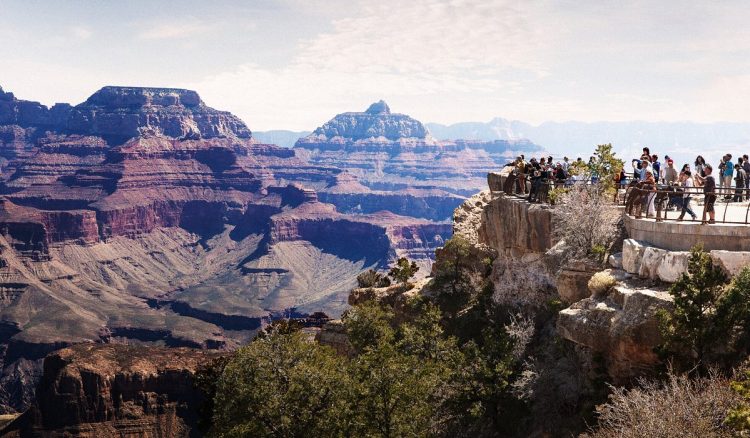Introduction
Grand Canyon National Park is one of the most iconic natural wonders in the world. Its sheer size, intricate rock formations, and breathtaking views have attracted millions of visitors each year from all over the globe. Whether you’re a nature enthusiast, a photographer, a hiker, or simply someone looking for an awe-inspiring experience, the Grand Canyon offers something for everyone. The park, located in the northern part of Arizona, is a testament to the power of natural forces that shaped the landscape over millions of years.
The Grand Canyon is not just a geographical marvel, but also a cultural and historical treasure. From the ancient Native American tribes who lived in and around the canyon, to the early European explorers, and the modern-day adventurers who brave its depths, the Grand Canyon has a rich and diverse history. But what makes this natural wonder a must-see destination for so many? In this article, we will delve into the history, geology, ecosystems, and recreational opportunities that make the Grand Canyon National Park one of the most visited natural attractions in the world.
1. A Geological Marvel: The Formation of the Grand Canyon
1.1 Geological History of the Grand Canyon
The Grand Canyon, which stretches for over 277 miles and reaches depths of over a mile, is a geological masterpiece. The canyon’s rock layers, exposed through centuries of erosion and tectonic shifts, tell the story of Earth’s history in a way that few other locations can match.
The process of forming the Grand Canyon began millions of years ago, during the Precambrian Era, when the region was covered by an ancient sea. As the Earth’s crust shifted, tectonic activity caused the region to uplift, and erosion began carving out the canyon’s distinctive features. Over time, the Colorado River played a significant role in shaping the canyon’s depths, cutting through the rock layers and creating the iconic ridges and valleys we see today.
The exposed rock layers at the Grand Canyon are some of the oldest on Earth, with the bottom layers dating back nearly 2 billion years. These rock formations offer a unique opportunity for geologists to study the Earth’s history, as they provide evidence of ancient seas, volcanic eruptions, and the forces of erosion and sedimentation that have shaped the planet over time.
1.2 Stratigraphy and Rock Layers
One of the most remarkable aspects of the Grand Canyon is its stratigraphy—the visible layers of rock that tell the story of the Earth’s geological history. The canyon walls reveal multiple layers of sedimentary rock, including limestone, sandstone, and shale, each representing a different time period in Earth’s history. The colors and textures of these layers vary, providing a striking visual display that is as educational as it is breathtaking.
The oldest rock formations, known as the Vishnu Schist, can be found at the bottom of the canyon and date back over 1.7 billion years. These rocks are primarily made up of ancient granite and metamorphic rocks. Above the Vishnu Schist are younger layers, such as the Redwall Limestone, which was deposited around 340 million years ago and is known for its striking red color. As you move upward through the canyon, you encounter layers such as the Bright Angel Shale and the Kaibab Limestone, each offering insights into the different climates and environments that existed in the distant past.
2. Cultural and Historical Significance
2.1 Native American History
The Grand Canyon has been inhabited by Native American tribes for thousands of years, and it holds great cultural and spiritual significance for these communities. The canyon is home to numerous archeological sites, many of which date back over 12,000 years. The Havasupai, Hopi, Navajo, and Zuni tribes, among others, have long considered the Grand Canyon sacred. These tribes have passed down their traditions, stories, and knowledge of the canyon through generations, and their deep connection to the land remains an integral part of the park’s cultural landscape.
For instance, the Hopi people view the Grand Canyon as a spiritual place, a location of sacred origin from which their ancestors emerged into the world. The Havasupai, who live near the base of the canyon, consider the canyon their ancestral home. Many Native American tribes have used the Grand Canyon for shelter, farming, and religious ceremonies, and their history continues to be an essential part of the park’s narrative.
2.2 European Exploration and Early History
The European discovery and exploration of the Grand Canyon began in the 16th century, with the Spanish explorer García López de Cárdenas being the first known European to view the canyon in 1540. However, the canyon remained largely unknown to the outside world for centuries after that, with the harsh conditions and remote location making it difficult to access.
In the 19th century, American explorers began to chart the canyon, and in 1869, Major John Wesley Powell famously led an expedition down the Colorado River, becoming the first person to navigate the river through the Grand Canyon. Powell’s journey helped to raise awareness of the canyon’s significance and paved the way for its eventual inclusion in the national park system.
In 1919, the Grand Canyon was designated as a national park, officially becoming a protected area and a symbol of America’s commitment to preserving its natural wonders for future generations.
3. Ecosystem Diversity and Wildlife
3.1 Vegetation Zones
Despite its arid environment, the Grand Canyon supports a wide range of plant life, thanks to the park’s varying elevation and microclimates. The canyon’s ecosystems are divided into several distinct vegetation zones, each with its unique flora and fauna. At the higher elevations, you’ll find pine forests, while the lower elevations are dominated by desert scrub and cactus. The riparian zones along the Colorado River are home to lush vegetation, including cottonwood and willow trees.
The diversity of plant life in the Grand Canyon makes it an ideal location for botanists and nature lovers alike. The park is home to hundreds of plant species, many of which are unique to the region. The prickly pear cactus, yucca, and various species of sagebrush are commonly found in the canyon’s desert landscapes, while the lush riparian areas provide a home for species such as the narrowleaf cottonwood.
3.2 Wildlife
The Grand Canyon is also home to an array of wildlife species, many of which are adapted to the extreme conditions of the canyon. The most iconic animals of the Grand Canyon include the bighorn sheep, which can be seen climbing the steep cliffs, and the California condor, a bird that has been successfully reintroduced to the region.
In addition to bighorn sheep and condors, the park is home to a variety of mammals, birds, reptiles, and amphibians. Visitors may spot elk, mule deer, coyotes, and mountain lions. The Colorado River is also teeming with fish, such as the endangered humpback chub and the rainbow trout. The park’s diverse ecosystems provide habitats for these animals, creating a dynamic and rich wildlife environment.

4. Recreation and Activities
4.1 Hiking and Trails
One of the main reasons visitors flock to the Grand Canyon is for its world-class hiking opportunities. The park boasts over 400 miles of hiking trails, ranging from short, easy walks to challenging backcountry treks. Some of the most popular trails include the South Kaibab Trail, which offers stunning panoramic views of the canyon, and the Bright Angel Trail, which descends into the canyon to the Colorado River.
For those looking to explore the canyon’s depths, the Rim-to-Rim hike, which spans across the entire canyon from the North Rim to the South Rim, is a challenging but rewarding experience. Hiking the Grand Canyon is not for the faint of heart, as the trails can be steep and strenuous, but the experience of standing at the bottom of one of the world’s most majestic canyons is unmatched.
4.2 River Rafting and Water Sports
Another popular way to experience the Grand Canyon is through river rafting on the Colorado River. Rafting trips through the canyon offer a unique perspective of the landscape, as visitors navigate the rapids and drift past towering rock formations. These rafting expeditions can range from a few hours to several days, with some trips providing overnight camping opportunities along the river’s edge.
For those not interested in whitewater rafting, calmer kayaking and canoeing opportunities are also available on the Colorado River, providing a more leisurely way to experience the canyon’s beauty.
4.3 Scenic Views and Photography
For many visitors, simply taking in the scenic vistas is the highlight of their trip to the Grand Canyon. The park offers numerous viewpoints along both the South Rim and North Rim, where visitors can gaze out over the expansive landscape and watch the changing light throughout the day. Sunrise and sunset are particularly magical times to visit, as the canyon’s rock layers shift in color, creating a mesmerizing display of reds, oranges, and purples.
The Grand Canyon is also a photographer’s paradise, offering countless opportunities for capturing stunning landscapes, wildlife, and natural features. Whether you’re an amateur photographer or a professional, the park’s dramatic vistas will leave you with unforgettable memories.
5. Tips for Visiting the Grand Canyon
5.1 Best Time to Visit
The best time to visit the Grand Canyon depends on the type of experience you’re seeking. The peak tourist season runs from spring through fall, with the summer months being the busiest. This is when the weather is warm, and most park services, including accommodations and tours, are fully operational. If you’re looking for fewer crowds, visiting during the spring or fall can offer a more peaceful experience with mild temperatures and fewer tourists.
Winter is also an option for those who enjoy a more tranquil visit, as the park is less crowded and the canyon is often covered in snow, creating a winter wonderland. However, some parts of the park, particularly the North Rim, may be closed due to snow.
5.2 Accommodations and Lodging
There are a variety of accommodations available for visitors to the Grand Canyon, ranging from campsites to luxury hotels. The South Rim, being the most accessible part of the park, has several hotels, including the historic El Tovar Hotel, which offers views of the canyon. For a more rustic experience, visitors can camp at one of the park’s campgrounds or stay in a backcountry lodge.
If you’re planning to hike or raft the canyon, it’s essential to plan ahead and make reservations early, as accommodations and permits can book up quickly, especially during peak seasons.
5.3 Staying Safe in the Canyon
While the Grand Canyon offers incredible beauty and adventure, it also requires preparation and caution. Hikers should bring plenty of water, wear appropriate footwear, and be prepared for the challenging terrain. It’s also crucial to be aware of the weather conditions, as temperatures can vary significantly between the canyon rim and the river below.
In addition to staying hydrated and prepared for the physical challenges of the canyon, visitors should be aware of the park’s wildlife and keep a safe distance from animals such as mountain lions, bighorn sheep, and snakes.
Conclusion
The Grand Canyon National Park is a treasure trove of natural wonders, rich history, and diverse ecosystems. From its geological significance to its cultural heritage, the canyon offers something for everyone, whether you’re an adventurer, a nature lover, a history buff, or simply someone looking to experience one of the most breathtaking landscapes on Earth.
Its vastness, beauty, and variety of activities make it an unforgettable destination for travelers from all over the world. Whether you’re hiking its trails, rafting its waters, or simply soaking in the stunning vistas, the Grand Canyon is a place that inspires awe and wonder. With its fascinating history, remarkable geology, and unique ecosystem, it’s no wonder that the Grand Canyon is a must-see destination for any traveler seeking to experience the majesty of nature.





















